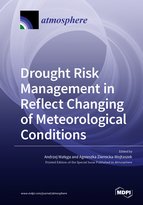Drought Risk Management in Reflect Changing of Meteorological Conditions
A special issue of Atmosphere (ISSN 2073-4433). This special issue belongs to the section "Meteorology".
Deadline for manuscript submissions: closed (15 July 2021) | Viewed by 33015
Special Issue Editors
Interests: surface hydrology; modelling of hydrological processes; urban water management; flood; drought; climate change
Special Issues, Collections and Topics in MDPI journals
Interests: meteorology and climatology; agrometeorology; extreme and harmful to agriculture meteorological phenomena; climate variability; present-day climate change and the results of global warming
Special Issue Information
Dear Colleagues,
Drought is one of the main extreme meteorological and hydrological phenomena that influence many key human activities and ecosystems. Around the world, different direct changes of meteorological and climatological conditions are observed, such as air temperature, moisture, precipitation, and evapotranspiration that significant influence drought. Land cover/land use can also be an indirect factor that can influence evapotranspiration and, thus, water balance in catchment. It can be influence the run in drought process. Additionally, climate change is one of the more visible factors that can increase the severity and frequency of drought. Drought is linked with changes to the hydrological regime and a decrease in water resources. Its results are observed in the various water-demand-related issues for people, agriculture (a very important problem in regions with large irrigation systems), and industry, and it can also be a problem for water ecosystems. To reflect the above information, reasonable drought risk management that can moderate problems with water demands in different sectors of human activities is critical.
Thus, in our opinion, an expansion of knowledge and challenges in drought maganement is needed to prevent water scarcity. Therefore, the main objective of this Special Issue is to contribute to our understanding of drought processes and the influence of the interactions between different factors and to provide science-based knowledge, new ideas/approaches and solutions in drought risk management. We encourage authors to share their opinions, knowledge, and achievements regarding meteorological condition trends and the influence of drought processes and interactions on human activities, and new methods of measurements of meteorologic factors, such as the use of satellite images to assess evaporation, precipitation, soil moisture, etc. and prognosis of drought and water scarcity. Additionally, examples of best practices in drought risk management will be very important to present in this Special Issue. In particular, the following topics are of great interest:
- Indicators of drought and their uncertainty;
- Modern techniques of measures of meteorological factors;
- Trends of meteorological factors and their interactions with human activities and water scarcity and water demands;
- Influence of drought on water demands of households, industrial, agriculture, and ecosystems;
- Drought risk management to prevent water scarcity;
- Climate change and influence on drought.
Dr. Andrzej Walega
Dr. Agnieszka Ziernicka-Wojtaszek
Guest Editors
Manuscript Submission Information
Manuscripts should be submitted online at www.mdpi.com by registering and logging in to this website. Once you are registered, click here to go to the submission form. Manuscripts can be submitted until the deadline. All submissions that pass pre-check are peer-reviewed. Accepted papers will be published continuously in the journal (as soon as accepted) and will be listed together on the special issue website. Research articles, review articles as well as short communications are invited. For planned papers, a title and short abstract (about 100 words) can be sent to the Editorial Office for announcement on this website.
Submitted manuscripts should not have been published previously, nor be under consideration for publication elsewhere (except conference proceedings papers). All manuscripts are thoroughly refereed through a single-blind peer-review process. A guide for authors and other relevant information for submission of manuscripts is available on the Instructions for Authors page. Atmosphere is an international peer-reviewed open access monthly journal published by MDPI.
Please visit the Instructions for Authors page before submitting a manuscript. The Article Processing Charge (APC) for publication in this open access journal is 2400 CHF (Swiss Francs). Submitted papers should be well formatted and use good English. Authors may use MDPI's English editing service prior to publication or during author revisions.
Keywords
- Drought risk management
- Meteorological factors and their influence on drought
- Water scarcity
- Sociohydrology
- Prognosis of drought
- Indicators of drought
- Climate change







